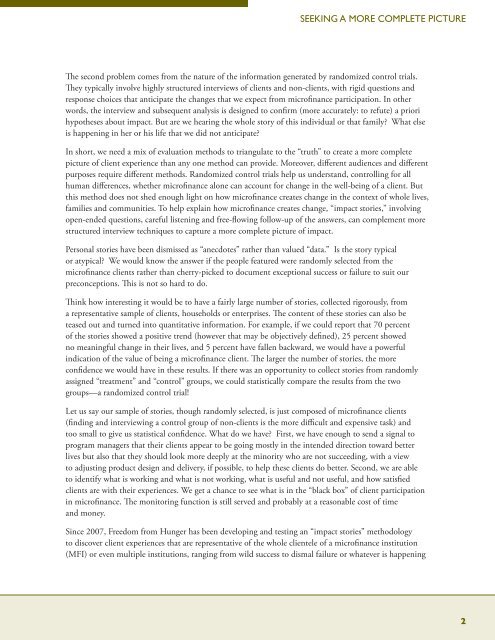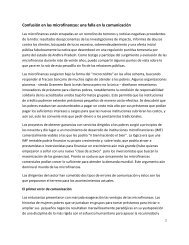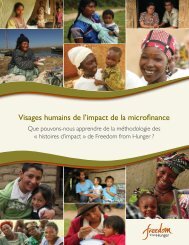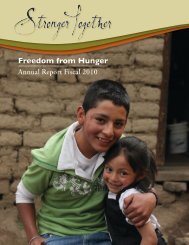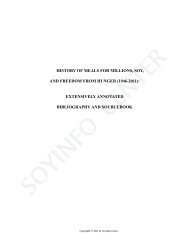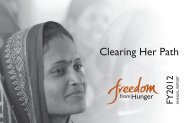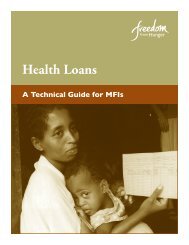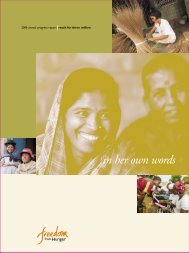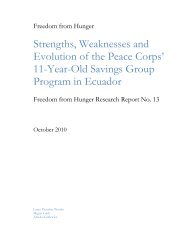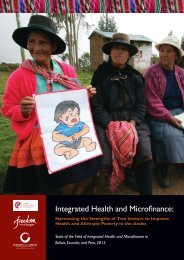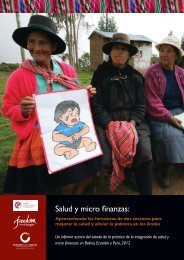English - Freedom from Hunger
English - Freedom from Hunger
English - Freedom from Hunger
Create successful ePaper yourself
Turn your PDF publications into a flip-book with our unique Google optimized e-Paper software.
seekIng a MoRe CoMPleTe PICTuRe<br />
The second problem comes <strong>from</strong> the nature of the information generated by randomized control trials.<br />
They typically involve highly structured interviews of clients and non-clients, with rigid questions and<br />
response choices that anticipate the changes that we expect <strong>from</strong> microfinance participation. In other<br />
words, the interview and subsequent analysis is designed to confirm (more accurately: to refute) a priori<br />
hypotheses about impact. But are we hearing the whole story of this individual or that family? What else<br />
is happening in her or his life that we did not anticipate?<br />
In short, we need a mix of evaluation methods to triangulate to the “truth” to create a more complete<br />
picture of client experience than any one method can provide. Moreover, different audiences and different<br />
purposes require different methods. Randomized control trials help us understand, controlling for all<br />
human differences, whether microfinance alone can account for change in the well-being of a client. But<br />
this method does not shed enough light on how microfinance creates change in the context of whole lives,<br />
families and communities. To help explain how microfinance creates change, “impact stories,” involving<br />
open-ended questions, careful listening and free-flowing follow-up of the answers, can complement more<br />
structured interview techniques to capture a more complete picture of impact.<br />
Personal stories have been dismissed as “anecdotes” rather than valued “data.” Is the story typical<br />
or atypical? We would know the answer if the people featured were randomly selected <strong>from</strong> the<br />
microfinance clients rather than cherry-picked to document exceptional success or failure to suit our<br />
preconceptions. This is not so hard to do.<br />
Think how interesting it would be to have a fairly large number of stories, collected rigorously, <strong>from</strong><br />
a representative sample of clients, households or enterprises. The content of these stories can also be<br />
teased out and turned into quantitative information. For example, if we could report that 70 percent<br />
of the stories showed a positive trend (however that may be objectively defined), 25 percent showed<br />
no meaningful change in their lives, and 5 percent have fallen backward, we would have a powerful<br />
indication of the value of being a microfinance client. The larger the number of stories, the more<br />
confidence we would have in these results. If there was an opportunity to collect stories <strong>from</strong> randomly<br />
assigned “treatment” and “control” groups, we could statistically compare the results <strong>from</strong> the two<br />
groups—a randomized control trial!<br />
Let us say our sample of stories, though randomly selected, is just composed of microfinance clients<br />
(finding and interviewing a control group of non-clients is the more difficult and expensive task) and<br />
too small to give us statistical confidence. What do we have? First, we have enough to send a signal to<br />
program managers that their clients appear to be going mostly in the intended direction toward better<br />
lives but also that they should look more deeply at the minority who are not succeeding, with a view<br />
to adjusting product design and delivery, if possible, to help these clients do better. Second, we are able<br />
to identify what is working and what is not working, what is useful and not useful, and how satisfied<br />
clients are with their experiences. We get a chance to see what is in the “black box” of client participation<br />
in microfinance. The monitoring function is still served and probably at a reasonable cost of time<br />
and money.<br />
Since 2007, <strong>Freedom</strong> <strong>from</strong> <strong>Hunger</strong> has been developing and testing an “impact stories” methodology<br />
to discover client experiences that are representative of the whole clientele of a microfinance institution<br />
(MFI) or even multiple institutions, ranging <strong>from</strong> wild success to dismal failure or whatever is happening<br />
2


